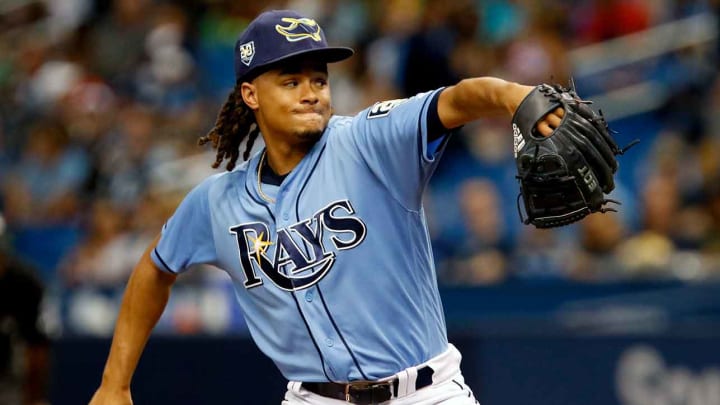Trade Grades: Surprising Pirates Pay Big Price to Acquire Chris Archer From Rays

The Pirates weren’t supposed to be here.
Go back to July 7. After a strong start to the year, Pittsburgh had been floundering for weeks. The Bucs had just lost five straight, dropping them ten games out of the wild card race and eight games below .500. They were, in other words, exactly what most people had expected back in spring training—not quite good enough to contend and not quite bad enough to be otherwise remarkable. It was the natural result of a winter where the front office had sent a clear message by trading away ace Gerrit Cole and franchise cornerstone Andrew McCutchen. After going 75-87 in 2017, Pittsburgh wasn’t making a serious attempt to win in 2018.
But then it did start winning, and winning a lot. Since July 7, the Pirates have gone 15-4, including a five-game sweep of tough division competition in Milwaukee. They’re now just three-and-a-half games out of a postseason berth. Tuesday's trade deadline, then, was an especially crucial point—and, as of a few days ago, the team’s direction was still an open question. In a crowded playoff race, with six teams bunched within four games of each other for two wild card spots, there was a fair case to be made for bowing out and selling. On the flip side, if they wanted any meaningful shot at contention, they had no choice but to buy as big as possible.
The Pirates chose the latter. In the final hour before the deadline, they pulled off a deal for the trade season’s most-buzzed-about arm, the Rays’ Chris Archer. The 29-year-old has been a regular fixture in trade rumors for almost his entire career; this time, finally, it was real, and Pittsburgh won the sweepstakes. But they paid a high price—rookie outfielder Austin Meadows and young pitcher Tyler Glasnow, plus a third piece to be named later.
Who Were the Biggest Winners and Losers of the 2018 MLB Trade Deadline?
With a collective starters’ 4.18 ERA and 4.33 FIP, Pittsburgh could certainly use rotation help. Archer provides that, but maybe not as much as this team needs. After receiving votes for Rookie of the Year in 2013 and the Cy Young in 2015, he’s met with some struggle over the last few years. In 2018, his strikeout rate is down, his walk rate is up and there isn’t much in his peripheral figures to suggest an explanation for his 4.31 ERA. (The fact that he spent almost the entirety of June on the disabled list with an abdominal injury doesn’t help.) But in a shallow starting pitching market, there weren’t too many other avenues worth pursuing, and Archer is still providing a boost in an area of need. He can provide that boost for several seasons, at that, as he’s under team control through 2021.
There’s a natural temptation to compare Archer to Pittsburgh’s former ace, Cole, who’s reached new heights since he was traded and has been one of baseball’s best pitchers this season. Consider that the price paid for Archer just might be higher than the value of the return for Cole, and that temptation gets especially hard to ignore. When Pittsburgh sent Cole to Houston in January, they received Joe Musgrove, who’s been perfectly fine as a middle-of-the-rotation arm; Michael Feliz, who’s been less fine out of the bullpen; third baseman Colin Moran, who’s passed his prospect hype but nevertheless has been solid; and minor-league outfielder Jason Martin. It was a well-rounded package, filling several holes that needed to be filled; Cole’s transformation makes it look pretty thin with the benefit of hindsight, but, well, you know what they say about hindsight. Acquiring Archer, meanwhile, meant giving up two of the club’s best young players. Meadows is a top prospect who found early success with his major league debut this year, posting a 1.261 OPS through 51 plate appearances. There are some caveats to note here—he’s struggled to stay healthy in the past, and he’s cooled off in the weeks since that first torrid stretch in the big leagues—but Meadows still has the potential to be among the game’s most exciting young outfielders. Glasnow has had a rockier time since making his debut two seasons ago, mostly owing to a high walk rate, but the reliever generates plenty of strikeouts and still has quite a bit of upside.
It is, of course, unfair to compare the two deals on a one-to-one framework like this. Archer has more years of team control; this is a different trade market than what baseball had over the winter; there’s that crucial matter of the benefit of hindsight. But the comparison still serves to highlight how drastically this team has changed its approach over the course of the season. The Pirates suddenly want to go for it here, and they’re willing to pay up to do so. It’s a fun move, and a bold one. The next few months will show whether it’s a fruitful one.
Pirates: B
Rays: A-

Emma Baccellieri is a staff writer who focuses on baseball and women's sports for Sports Illustrated. She previously wrote for Baseball Prospectus and Deadspin, and has appeared on BBC News, PBS NewsHour and MLB Network. Baccellieri has been honored with multiple awards from the Society of American Baseball Research, including the SABR Analytics Conference Research Award in historical analysis (2022), McFarland-SABR Baseball Research Award (2020) and SABR Analytics Conference Research Award in contemporary commentary (2018). A graduate from Duke University, she’s also a member of the Baseball Writers Association of America.
Follow emmabaccellieri